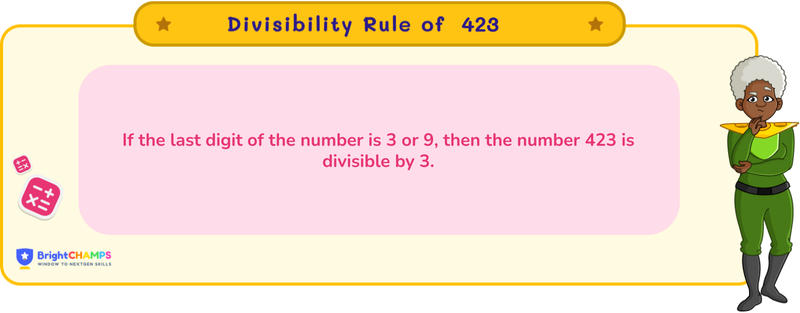Summarize this article:
 290 Learners
290 LearnersLast updated on August 5, 2025
Divisibility Rule of 423

The divisibility rule is a way to find out whether a number is divisible by another number without using the division method. In real life, we can use the divisibility rule for quick math, dividing things evenly, and sorting things. In this topic, we will learn about the divisibility rule of 423.

What is the Divisibility Rule of 423?
The divisibility rule for 423 is a method by which we can find out if a number is divisible by 423 or not without using the division method. Check whether 846 is divisible by 423 with the divisibility rule.
Step 1: Check the divisibility of the number by its prime factors. The prime factors of 423 are 3, 47, and 3.
Step 2: Check if the number is divisible by 3. A number is divisible by 3 if the sum of its digits is a multiple of 3. For 846, the sum of the digits is 8+4+6=18, which is a multiple of 3.
Step 3: Check if the number is divisible by 47. This can be done by performing the division method or a special rule for 47.
Step 4: If the number is divisible by both 3 and 47, then it is divisible by 423.


Tips and Tricks for Divisibility Rule of 423
Learn divisibility rules to help master division. Let’s learn a few tips and tricks for the divisibility rule of 423.
Know the prime factors:
Memorize the prime factors of 423 (3 and 47) to quickly check divisibility. The number must be divisible by both 3 and 47.
Use the sum of digits for 3:
If the sum of the digits is a multiple of 3, then the number is divisible by 3.
Verify with 47:
Learn a shortcut method or use division for checking divisibility by 47.
Repeat the process for large numbers:
Students should keep repeating the divisibility process for each factor until they reach a conclusion. For example, check if 1692 is divisible by 423. The sum of the digits is 1+6+9+2=18, which is divisible by 3. Now check if 1692 is divisible by 47. If both conditions are met, then 1692 is divisible by 423.
Use the division method to verify:
Students can use the division method as a way to verify and cross-check their results. This will help them to verify and also learn.

Common Mistakes and How to Avoid Them in Divisibility Rule of 423
The divisibility rule of 423 helps us quickly check if a given number is divisible by 423, but common mistakes like calculation errors lead to incorrect conclusions. Here we will understand some common mistakes and how to avoid them.
Explore Our Programs



Divisibility Rule of 423 Examples

Problem 1
Is 846 divisible by 423?

Yes, 846 is divisible by 423.
Explanation
To determine if 846 is divisible by 423, we can use the divisibility rule for 423.
1) Divide the number by 423 directly, 846 ÷ 423 = 2.
2) Since the result is an integer, 846 is divisible by 423.

Problem 2
Check the divisibility rule of 423 for 1269.

Yes, 1269 is divisible by 423.
Explanation
To verify the divisibility of 1269 by 423:
1) Divide the number by 423, 1269 ÷ 423 = 3.
2) The result is an integer, confirming 1269 is divisible by 423.

Problem 3
Is -2115 divisible by 423?

No, -2115 is not divisible by 423.
Explanation
To check if -2115 is divisible by 423, we disregard the negative sign:
1) Divide the number by 423, 2115 ÷ 423 = 5.
2) Since the result is not an integer, -2115 is not divisible by 423.

Problem 4
Can 1057 be divisible by 423 following the divisibility rule?

No, 1057 is not divisible by 423.
Explanation
To check if 1057 is divisible by 423:
1) Divide the number by 423, 1057 ÷ 423 ≈ 2.5.
2) The result is not an integer, indicating 1057 is not divisible by 423.

Problem 5
Check the divisibility rule of 423 for 2115.

Yes, 2115 is divisible by 423.
Explanation
To confirm divisibility of 2115 by 423:
1) Divide the number by 423, 2115 ÷ 423 = 5.
2) The result is an integer, so 2115 is divisible by 423.


FAQs on Divisibility Rule of 423
1.What is the divisibility rule for 423?
2. How many numbers between 1 and 1000 are divisible by 423?
3. Is 846 divisible by 423?
4.What if I get 0 after subtraction for divisibility by a factor?
5.Does the divisibility rule of 423 apply to all integers?

Important Glossaries for Divisibility Rule of 423
- Divisibility rule: The set of rules used to find out whether a number is divisible by another number or not.
- Prime factors: The prime numbers that multiply together to give the original number. For 423, the prime factors are 3 and 47.
- Multiples: Multiples are the results we get after multiplying a number by an integer.
- Sum of digits: The total obtained by adding all the individual digits of a number together.
- Division method: A mathematical process used to determine how many times one number is contained within another.



Hiralee Lalitkumar Makwana
About the Author
Hiralee Lalitkumar Makwana has almost two years of teaching experience. She is a number ninja as she loves numbers. Her interest in numbers can be seen in the way she cracks math puzzles and hidden patterns.
Fun Fact
: She loves to read number jokes and games.

















